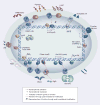Understanding the regulation of Group B Streptococcal virulence factors
- PMID: 19257847
- PMCID: PMC2691590
- DOI: 10.2217/17460913.4.2.201
Understanding the regulation of Group B Streptococcal virulence factors
Abstract
Bacterial infections remain a significant threat to the health of newborns and adults. Group B Streptococci (GBS) are Gram-positive bacteria that are common asymptomatic colonizers of healthy adults. However, this opportunistic organism can also subvert suboptimal host defenses to cause severe invasive disease and tissue damage. The increasing emergence of antibiotic-resistant GBS raises more concerns for sustained measures in treatment of the disease. A number of factors that are important for virulence of GBS have been identified. This review summarizes the functions of some well-characterized virulence factors, with an emphasis on how GBS regulates their expression. Regulatory and signaling molecules are attractive drug targets in the treatment of bacterial infections. Consequently, understanding signaling responses of GBS is essential for elucidation of pathogenesis of GBS infection and for the identification of novel therapeutic agents.
Figures


Similar articles
-
The sensor histidine kinase RgfC affects group B streptococcal virulence factor expression independent of its response regulator RgfA.Infect Immun. 2015 Mar;83(3):1078-88. doi: 10.1128/IAI.02738-14. Epub 2015 Jan 5. Infect Immun. 2015. PMID: 25561709 Free PMC article.
-
Pan-GWAS of Streptococcus agalactiae Highlights Lineage-Specific Genes Associated with Virulence and Niche Adaptation.mBio. 2020 Jun 9;11(3):e00728-20. doi: 10.1128/mBio.00728-20. mBio. 2020. PMID: 32518186 Free PMC article.
-
Two-Component Signal Transduction Systems in the Human Pathogen Streptococcus agalactiae.Infect Immun. 2020 Jun 22;88(7):e00931-19. doi: 10.1128/IAI.00931-19. Print 2020 Jun 22. Infect Immun. 2020. PMID: 31988177 Free PMC article. Review.
-
Biofilm formation by Streptococcus agalactiae: influence of environmental conditions and implicated virulence factors.Front Cell Infect Microbiol. 2015 Feb 4;5:6. doi: 10.3389/fcimb.2015.00006. eCollection 2015. Front Cell Infect Microbiol. 2015. PMID: 25699242 Free PMC article. Review.
-
The CiaR response regulator in group B Streptococcus promotes intracellular survival and resistance to innate immune defenses.J Bacteriol. 2009 Apr;191(7):2023-32. doi: 10.1128/JB.01216-08. Epub 2008 Dec 29. J Bacteriol. 2009. PMID: 19114476 Free PMC article.
Cited by
-
Genotypes and virulence genes in group B streptococcus isolated in the maternity hospital, Kuwait.Med Princ Pract. 2013;22(5):453-7. doi: 10.1159/000349932. Epub 2013 Apr 5. Med Princ Pract. 2013. PMID: 23571853 Free PMC article.
-
Colonization of Streptococcus agalactiae among pregnant patients in Trinidad and Tobago.IJID Reg. 2022 Mar 18;3:96-100. doi: 10.1016/j.ijregi.2022.03.010. eCollection 2022 Jun. IJID Reg. 2022. PMID: 35755456 Free PMC article.
-
Association and virulence gene expression vary among serotype III group B streptococcus isolates following exposure to decidual and lung epithelial cells.Infect Immun. 2014 Nov;82(11):4587-95. doi: 10.1128/IAI.02181-14. Epub 2014 Aug 18. Infect Immun. 2014. PMID: 25135682 Free PMC article.
-
Evaluation in Mouse Model of Combined Virus-bacterial Vaccine Based on Attenuated Influenza A(H7N3) Virus and the Group B Streptococcus Recombinant Polypeptides.Open Microbiol J. 2016 Oct 31;10:168-175. doi: 10.2174/1874285801610010168. eCollection 2016. Open Microbiol J. 2016. PMID: 27867430 Free PMC article.
-
Regulation of hemolysin expression and virulence of Staphylococcus aureus by a serine/threonine kinase and phosphatase.PLoS One. 2010 Jun 11;5(6):e11071. doi: 10.1371/journal.pone.0011071. PLoS One. 2010. PMID: 20552019 Free PMC article.
References
-
- Berner R. Significance, management and prevention of Streptococcus agalactiae infection during the perinatal period. Expert Rev Anti Infect Ther. 2004;2:427–437. - PubMed
-
- van der Poll T, Opal SM. Host–pathogen interactions in sepsis. Lancet Infect Dis. 2008;8:32–43. - PubMed
-
- Campbell JR, Hillier SL, Krohn MA, Ferrieri P, Zaleznik DF, Baker CJ. Group B Streptococcal colonization and serotype-specific immunity in pregnant women at delivery. Obstet Gynecol. 2000;96:498–503. - PubMed
-
- Mullaney DM. Group B Streptococcal infections in newborns. J Obstet Gynecol Neonatal Nurs. 2001;30:649–658. - PubMed
-
- Cowgill K, Taylor TH, Jr, Schuchat A, Schrag S. Report from the CDC. Awareness of perinatal Group B Streptococcal infection among women of childbearing age in the United States, 1999 and 2002. J Womens Health (Larchmt) 2003;12:527–532. - PubMed
Publication types
MeSH terms
Substances
Grants and funding
LinkOut - more resources
Full Text Sources
